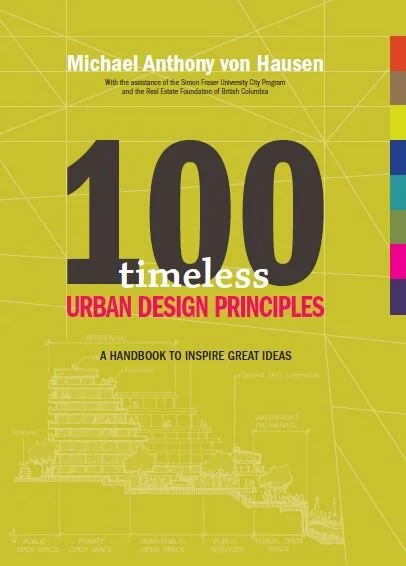 Image 1 of 1
Image 1 of 1


100 Timeless Urban Design Principles (2008 Edition)
115 pages.
Many urban design books are long on words and short on practical information. This handbook is intended to be a convenient resource for all the people who help shape our cities, towns, and villages: not only architects, landscape architects, and planners, but also community activists, developers, engineers, and politicians. It’s a beginning … to help spread information to a wider audience in a format that is more accessible and easier to understand. The content might even seem over-simplified, but the intent is to convey complex ideas in simple terms so that they can be both understood and reapplied in other contexts. Whether you are looking for urban design solutions for streets, buildings, or an entire region, hopefully this handbook will deliver fresh and practical ideas.
The platform for these principles are the built environment achievements evident over 2000 years of history in Rome, Florence, Siena, Venice, and Paris which are transmitted into the “100 timeless urban design principle” described on these pages.
I am aware that some people might think that European references are not relevant to North America. Europe is built to last, which is why I have used it as a platform for the principles.
North American design and construction, in many cases, is “disposable” after 50 years. Building on these European examples, as well as those from North America and other parts of the world, we can create successful people-oriented cities, towns, and villages while ensuring enduring and authentic character.
This handbook is arranged from the large scale of the region to the small scale of the block and building. The principles are numbered 1 to 100, creating an easy-to-reference collection of principles that can help focus on a specific topic quickly.
115 pages.
Many urban design books are long on words and short on practical information. This handbook is intended to be a convenient resource for all the people who help shape our cities, towns, and villages: not only architects, landscape architects, and planners, but also community activists, developers, engineers, and politicians. It’s a beginning … to help spread information to a wider audience in a format that is more accessible and easier to understand. The content might even seem over-simplified, but the intent is to convey complex ideas in simple terms so that they can be both understood and reapplied in other contexts. Whether you are looking for urban design solutions for streets, buildings, or an entire region, hopefully this handbook will deliver fresh and practical ideas.
The platform for these principles are the built environment achievements evident over 2000 years of history in Rome, Florence, Siena, Venice, and Paris which are transmitted into the “100 timeless urban design principle” described on these pages.
I am aware that some people might think that European references are not relevant to North America. Europe is built to last, which is why I have used it as a platform for the principles.
North American design and construction, in many cases, is “disposable” after 50 years. Building on these European examples, as well as those from North America and other parts of the world, we can create successful people-oriented cities, towns, and villages while ensuring enduring and authentic character.
This handbook is arranged from the large scale of the region to the small scale of the block and building. The principles are numbered 1 to 100, creating an easy-to-reference collection of principles that can help focus on a specific topic quickly.
